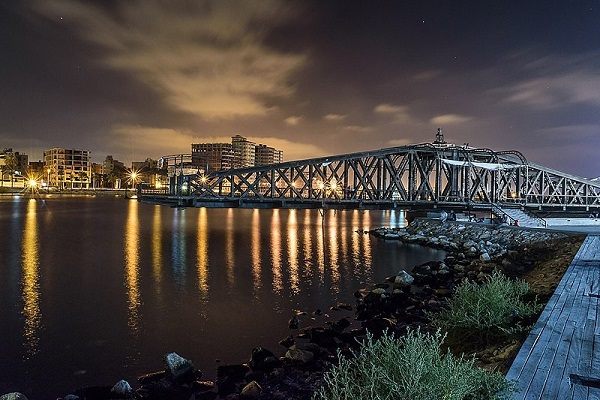
–>
June 6, 2022
Today in history, on June 6, Louis IX of France — better known to posterity as Saint Louis — scored a dramatic victory over Islam.
‘); googletag.cmd.push(function () { googletag.display(‘div-gpt-ad-1609268089992-0’); }); }
It was late May, 1249, and the Seventh Crusade had begun. Louis and his army, which consisted of some twenty-five thousand Crusaders, set sail from Cyprus. Their destination, based on the by now standard Crusader logic that Egypt must be neutralized before Jerusalem could be secured, was the Egyptian port of Damietta.
Considering that Damietta was also the focus of the Fifth Crusade (1217–1221), none of this came as a surprise to Egyptian sultan al-Salih Ayyub. He sent men under Emir Fahreddin to refortify Damietta’s garrison and hold the coast against any Crusader landing. He next sent a message warning Louis to forfend: “no one has ever attacked us without feeling our superiority,” the sultan boasted. “Recollect the conquests we have made from the Christians; we have driven them from the lands they possessed; their strongest towns have fallen under our blows.”
The heart of the Muslim world, the Middle East and North Africa — from Iraq in the east to Morocco in the west — later Turkey, and for centuries Spain and the Balkans, was originally inhabited by and conquered from Christians. Muslims, such as Sultan al-Salih Ayyub, were well aware of this fact and enjoyed throwing it in Christians’ faces.
‘); googletag.cmd.push(function () { googletag.display(‘div-gpt-ad-1609270365559-0’); }); }
By June 4, the Christian fleet had anchored on the west bank of the Nile, across from Damietta. Between it and the city, legions of Muslims lined the shore and riverbank, where they “made a loud and terrible noise with horns and cymbals.” A council was held in the king’s ship. Although some said to wait for the other ships that had been delayed by a storm, Louis was set on taking the shore now. “Our men,” wrote Gui, one of the knights present, “seeing the lord King’s steadfastness and unwavering resolve, at his bidding made ready … to occupy the shore by force and go on land.” When his counselors urged him not to join in the initial landing, due to the danger it posed to his person, Louis responded, “I am only one individual whose life, when God wills it, will be snuffed out like any other man’s.”
And so, on June 6, to a loud battle cry, the Crusaders furiously paddled to the shore in smaller boats, and “in accordance with the lord King’s strict and most urgent command, hastily leaped into the sea up to their loins.” Clad in heavy iron and slowly plodding toward the coast, they were met by and fended off a hail of arrows. “Of all the ships, the lord King’s put in first,” continues Gui. “Louis leapt into the water up to his armpits and waded ashore, shield round neck, helm on head, and sword in hand.” Jean de Joinville (1224–1317), a close friend of Louis who participated in the Crusade, continues: “So soon as they [Muslims] saw us land, they came toward us, hotly spurring. We, when we saw them coming, fixed the points of our shields into the sand and the handles of our lances in the sand with the points set towards them.”
Confronted by this massive spike-studded shield wall, and seeing “the lances about to enter into their bellies,” the Muslims “turned about and fled” — all except one, who, thinking his comrades were charging behind him, was instantly “cut down.” Thereafter, the Crusaders “fell manfully upon the enemies of the Cross like strong athletes of the Lord,” writes Gui: “the armed Saracens, stationed mounted on the shore, disputed the land with us … maintaining a dense fire of javelins and arrows against our men. And yet our men … pushed on and set foot on the land despite the Saracens.” The more the Muslims gave way, the more the Christians advanced onto dry ground. Before long, horses had been ferried over and mounted, leading to heavy, splashy cavalry charges, all under the cover of missile fire from the Christian fleet. Terrified by such daring, the Muslims tucked tail and ran.
Rather than falling back on and holding Damietta, Emir Fahreddin entirely fled the scene. On seeing this ignominious retreat, and not wanting to face, in the words of Muslim chroniclers, “the fury of the Christians,” the garrison in Damietta, followed by its entire citizenry, fled the city under the cover of night in great disorder and panic — “barefoot and unclad, hungry and thirsty, in poverty and disarray, women and children” — though not before cutting the throats or “dashing out the brains” of most of their Christian prisoners, many of whom had been captured during the Fifth Crusade.
A few escaped captives and slaves intercepted the Crusaders on their march to Damietta, which they were astonished to find deserted. On the morning following this spectacular start to his Crusade, Louis and his men went to Damietta’s chief mosque. “Here, three days earlier,” a shocked Gui wrote, “the prisoners categorically assured us, the most filthy Mahomet had been glorified with abominable sacrifices, cries from on high, and the blast of trumpets.” But because the mosque was formerly a church — “where [Coptic] Christians long ago had been in the habit of celebrating Mass and ringing their bells” — the king had the mosque purified with holy water and, “once it had been utterly purged of the pagans’ filth,” had Mass celebrated there. In this manner, and as Louis’s mother, Blanche, wrote to Henry III, “the site of the mosque, which some time ago — when the city was previously captured [by Muslims in the seventh century] — was the Church of the Blessed Virgin Mary, was reconciled and thanks were given there to God Most High.”
As these accounts make clear, thirteenth-century Europeans were not oblivious to the fact that all of the Near East and North Africa — not just Jerusalem — was originally part of Christendom. This comes out especially in the Crusaders’ talk concerning Egypt. For example, the foundation charter for the re-consecration of this church-turned-mosque-turned-church again, dated November 1249, makes the following assertions: “after this country [Egypt] is liberated from the hands of the infidels” and “when this land is liberated.” Similarly, Guillaume de Sonnac, the grand master of the Templars, wrote about how “the Lord King plans … to return the entire country [of Egypt] to Christian worship.”
‘); googletag.cmd.push(function () { googletag.display(‘div-gpt-ad-1609268078422-0’); }); } if (publir_show_ads) { document.write(“
At any rate, it was an amazing start to the Seventh Crusade.
This article was abstracted from Raymond Ibrahim’s new book, Defenders of the West: The Christian Heroes Who Stood against Islam (which includes a chapter on Louis IX, or Saint Louis). Ibrahim is a Shillman Fellow at the David Horowitz Freedom Center, a Judith Rosen Friedman Fellow at the Middle East Forum, and a Distinguished Senior Fellow at the Gatestone Institute.

Image: Ayman Muhammad Elshahat via Wikimedia Commons, CC BY-SA 4.0.
<!– if(page_width_onload <= 479) { document.write("
“); googletag.cmd.push(function() { googletag.display(‘div-gpt-ad-1345489840937-4’); }); } –> If you experience technical problems, please write to [email protected]
FOLLOW US ON
<!–
–>
<!– _qoptions={ qacct:”p-9bKF-NgTuSFM6″ }; ![]() –> <!—-> <!– var addthis_share = { email_template: “new_template” } –>
–> <!—-> <!– var addthis_share = { email_template: “new_template” } –>






